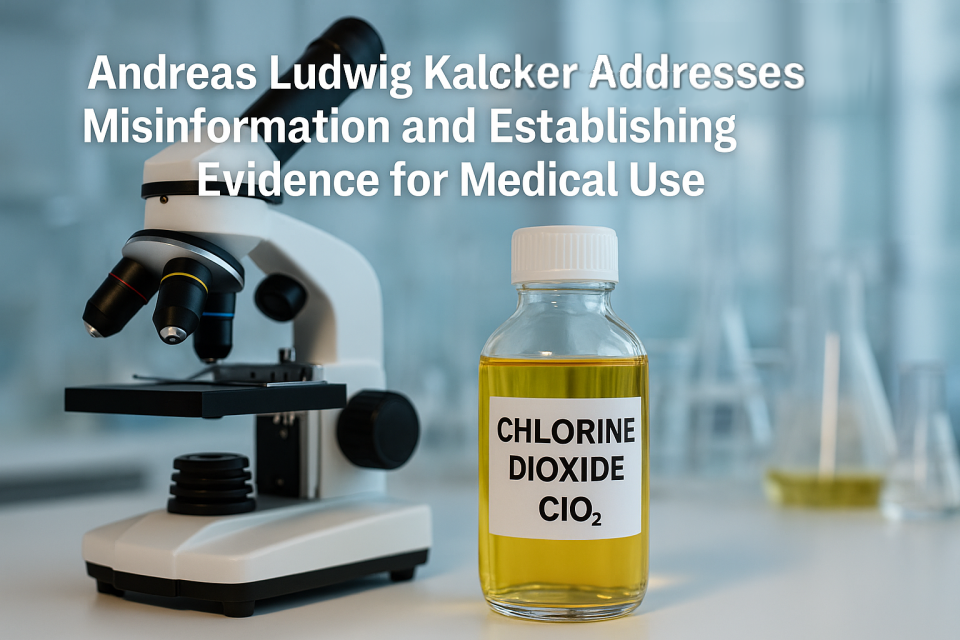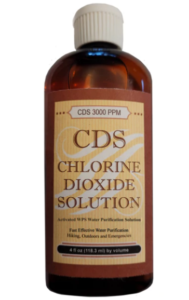In recent years, Chlorine Dioxide Solution (CDS) has emerged as both a subject of intense debate and a beacon of hope in the world of alternative and integrative medicine. Often misunderstood and misrepresented in media and public discourse, CDS—a dilute aqueous form of chlorine dioxide gas—has been safely used in water purification and sanitation for decades. However, its proposed use in medical settings has drawn controversy, fueled by regulatory ambiguity, misinformation, and sensationalized reporting.
The following summary presents the findings of a peer-reviewed scientific review published in the International Journal of Multidisciplinary Research and Analysis (March 2025) by Dr. h.c. Andreas Ludwig Kalcker. Drawing from over 40 cited studies and real-world testimonies, the review separates myth from fact, highlights the scientific foundation of CDS, and argues for evidence-based evaluation rather than fear-driven dismissal. This overview aims to clarify the safety profile, documented antimicrobial power, and emerging therapeutic potential of CDS, especially at low concentrations below 1 mg/L, while calling for further clinical validation and responsible regulation.
This peer-reviewed article addresses the scientific foundation, safety, and therapeutic potential of Chlorine Dioxide Solution (CDS), while debunking common misinformation.
- What is CDS?
-
- CDS is a dilute, aqueous solution of chlorine dioxide (ClO₂) gas (typically <1 mg/L).
- It is not the same as industrial bleach which contains sodium chlorite and can form harmful byproducts.
- CDS is widely used in water purification and food processing due to its selective antimicrobial action and low toxicity at therapeutic doses.
- Safety Profile:
-
- EPA LD50 for ClO₂ is 292 mg/kg, which means toxicity would require impractical ingestion volumes (e.g., ~20 liters for a 70-kg adult).
- Peer-reviewed studies (Ma et al., Ogata & Shibata, University of Almería) show no cytotoxic effects at therapeutic levels (0.3–0.8 mg/L).
- CDS does not form harmful chlorite ions when used correctly.
- The widely cited Neuquén, Argentina case (2020) falsely blamed CDS for a child’s death; autopsy evidence and expert testimony showed no causal link.
- Proven Antimicrobial Efficacy:
-
- Effective against bacteria (e.g., MRSA, E. coli), viruses (e.g., SARS-CoV-2, H1N1), fungi (e.g., Candida), and protozoa at low concentrations.
- Demonstrated broad-spectrum disinfection without damaging human cells.
- CDS is a size-selective oxidant, sparing healthy tissue while attacking pathogens.
- Emerging Therapeutic Potential:
-
- In vitro and anecdotal evidence suggest promise in treating cancer, Lyme disease, and viral infections:
- Selective cancer cell apoptosis at 0.4–0.6 mg/L.
- Borrelia (Lyme) inactivation and biofilm disruption.
- SARS-CoV-2 spike protein neutralization in vitro.
- In vitro and anecdotal evidence suggest promise in treating cancer, Lyme disease, and viral infections:
- Observational Testimonies:
-
- Data from platforms like dioxitube.com and dioxipedia.com show 78% improvement in symptoms for various conditions (e.g., lupus, skin infections) at safe doses.
- These testimonials, while not clinical trials, resemble the early public use of now-validated treatments like aspirin and penicillin.
- Misinformation and Media Bias:
-
- CDS is wrongly labeled as bleach (sodium hypochlorite) by the media and regulators.
- Agencies like the FDA, WHO, and others issue non-dose-specific warnings, confusing CDS with toxic variants.
- Public fear is driven by media distortion, not science.
Recommendations:
- Public Education: Disseminate accurate, accessible info via platforms like dioxipedia.com.
- Regulatory Reform: Create clear, form-specific, and dose-specific guidelines.
- Clinical Trials: Invest in rigorous studies to validate therapeutic uses in cancer, Lyme disease, and viral infections.
Conclusion:
CDS, when used properly at therapeutic levels, is safe, effective, and potentially transformative for medicine. Misinformation and regulatory overreach hinder its responsible exploration. The article calls for transparency, scientific rigor, and open-minded investigation to realize the benefits of this underappreciated compound.
- CDS remains safe and non-toxic at therapeutic concentrations (<1 mg/L), supported by studies from:
- Ma et al. (2017) demonstrated safety in animal models.
- Ogata and Shibata (2008) found no cytotoxic effects in human cells.
- University of Almería (2020) – confirmed absence of adverse effects up to 1 mg/L.
- Broad-spectrum antimicrobial efficacy is well documented:
- Proven effective against bacteria (MRSA, antibiotic-resistant strains), viruses (e.g., SARS-CoV-2, rotavirus), fungi (Candida), and protozoa.
- In vitro and real-world applications have shown significant promise in decontaminating clinical environments and reducing viral loads.
- Therapeutic potential in chronic conditions:
- Cancer: CDS induces selective apoptosis in cancer cells (e.g., small-cell lung, breast, colorectal).
- Lyme disease: In vitro studies show Borrelia burgdorferi inactivation and biofilm disruption.
- COVID-19: CDS appears to neutralize spike protein toxicity through redox mechanisms.
- Real-world case reports and compassionate use studies (e.g., Fernández, Schwartz, Aparicio-Alonso) document remission or stabilization in cancer and infectious diseases.
Observational Testimonies and Anecdotal Evidence:
- Data from dioxitube.com and dioxipedia.com reflect public-perceived benefits across various illnesses, most notably:
- Skin conditions, lupus, infections, vaccine-related rashes, and necrotic wounds.
- While not controlled clinical trials, these reports follow historical patterns seen in the early adoption of aspirin, digitalis, penicillin, and quinine—substances that were once dismissed before validation.
Call for Action and Final Recommendations:
- Public Education – Campaigns to clearly differentiate CDS from bleach using scientific platforms like Dioxipedia.
- Regulatory Reform – Agencies like the FDA, WHO, and others should issue form- and dose-specific guidelines, reflecting scientific data rather than blanket warnings.
- Investment in Clinical Trials – Urged to validate CDS’s use in cancer, Lyme disease, and viral infections, leveraging its redox selectivity and safety profile.
If validated by future studies, CDS could be “the biggest medical discovery of the century.”
Referenced Studies (Highlights):
| Study | Focus | Key Finding |
| Georgiou & Kotzé (2023) | Bacterial Infections | Eradicated multiple drug-resistant bacteria with 0.6 mg/L CDS. |
| Kim et al. (2022) | Cancer | CDS induced apoptosis in small-cell lung cancer cells at 0.4 mg/L. |
| Schwartz (2022) | Lyme Disease | In vitro eradication of Borrelia at 0.5 mg/L. |
| Wang et al. (2021) | SARS-CoV-2 | Virus inactivated at 0.8 mg/L CDS, outperforming sodium hypochlorite. |
| Ogata (2008) | Viral Protection | Low-dose ClO₂ gas protected mice from influenza. |
| Aparicio-Alonso (2024) | Clinical Cancer Cases | Compassionate CDS therapy showed tumor regression and improved outcomes. |
| El Fakir et al. (2023) | Spike Protein Toxicity | CDS neutralized COVID-19 spike protein toxicity in vitro. |
Dozens of other citations reinforce CDS’s low toxicity, potent antimicrobial capacity, and therapeutic promise.
Final Thoughts:
The article ends by reiterating that CDS is scientifically distinct from harmful chlorine compounds, and at concentrations under 1 mg/L, it has never shown toxicity in legitimate studies. Its role in medicine should be evaluated through evidence-based investigation, not misinformation or fear.
The authors urge health leaders to shift the narrative from vilification to validation—so that this “safe, accessible, and potentially groundbreaking therapy” may be properly assessed and, if confirmed, ethically integrated into modern healthcare.
Resource:
Title: Clarifying the Science of Chlorine Dioxide Solution (CDS): Addressing Misinformation and Establishing Evidence for Medical Use
Author: Dr. h.c. Andreas Ludwig Kalcker
Journal: International Journal of Multidisciplinary Research and Analysis, Vol. 8, Issue 3, March 2025
Pages: 1367–1374
DOI: 10.47191/ijmra/v8-i03-54
Access Full Report HERE.

